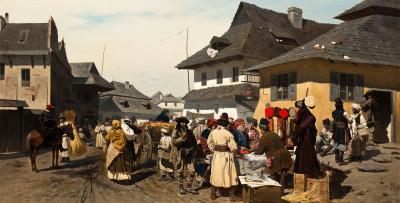Szerner, Władysław

Władysław Szerner, Polish painter and graphic artist, member of the "Munich School". From 1865-67, he studied at the Academy of Fine Arts, Munich. He lived and worked as an artist in Munich until the end of his life. *3 June 1836 in Warsaw, †4 January 1915 in Munich-Unterhaching. Son of a landowner (according to the Munich matriculation register) and administrative officer. Father of the painter Władysław Karol Szerner (1870-1936, member of the "Munich School"). After attending the Warsaw Institute for the Nobility/Instytut Szlachecki where he had his first training as an artist, Szerner attended the School of Fine Arts/Szkoła Sztuk Pięknych w Warszawie until 1862 under the historical, icon and portrait painter Rafał Hadziewicz (1803-1883). In 1863, he took part in the January Uprising and was detained by the Austrians in Auschwitz/Oświęcim. Later on, he evidently lived in Częstochowa. On 23 October 1865, he joined the antiquity class given by Alexander Strähuber (1814-1882) at the Royal Academy of Fine Arts in Munich. He studied under Sandór (Alexander von) Wagner (1838-1919), Hermann Anschütz (1802-1880) and Wilhelm Diez (1839-1907) until 1867. Szerner, who arrived in Munich totally impoverished, kept in close contact with the developing Polish painter colony in Munich, especially with Józef Brandt (1841-1915), who had studied in Munich since 1863 and later became the centrepoint of the "Colony of Poles", and with Władysław Czachórski (1850-1911, both members of the "Munich School"), who arrived in Munich in 1869 to study. In 1869/70, he married Apolonia, née Gepert (*ca. 1834); their son Władysław Karol was born on their family’s estate in Przybenice near Skalbmierz in 1870. From 1872, Szerner regularly provided the Warsaw newspaper Kłosy, and from 1881 the literary magazines Biesiada Literacka and Ziarno with reproductions of paintings, particularly genre scenes. From 1874-1909, he was a member of the Kunstverein München where, from 1875 to 1878, he sold paintings depicting folkloric motifs from Poland as annual raffle prizes. He became close friends with Brandt. Szerner lived and worked in Brandt’s prestigious atelier which Brandt had opened at Schwanthalerstraße 19 in 1874/75 and which was furnished with historical antiquities from Poland and the Ukraine. Even after this date, Szerner acted as a curator of the historical collection in Brandt’s atelier and let visitors in whenever he was away. In 1876, Szerner drew scenes from Brandt’s atelier, which were published in the magazine Kłosy. From 1877, he was one of the Polish artists for whom Brandt organised a summer academy for plein air painting at his estate in Orońsko to the southwest of Radom. At the beginning of the 1890s, he travelled to the territory of the Hutsuls in the Carpathians. He regularly exhibited his works in Poland until 1905. In the last years of his life, an illness prevented him from working on his art. – Largely influenced by Józef Brandt, Szerner mainly painted rider formations, individual soldiers and horses from the Cossack wars and the Tartar invasions of the 17th century ("Patrol"; "Sentry/Wartownik", both undated, oil), groups of riders with their horses resting in the open countryside ("Resting/Na popasie", oil, ca. 1880), hunters riding with their hounds and peasant scenes from the region of Kraków (see cover image), all with colourful, picturesque costumes but as a realistic concept. However, his portrayal of the scenery, the image detail, the perspective and the light failed to match the drama of the scenes that Brandt painted. Mostly in a small format, his paintings are executed masterfully and quite perfectly and sell well both in Germany and in Poland. From 1893-1900, he exhibited scenes from the Carpathian region of the Hutsuls at the Society for the Promotion of Fine Arts in Warsaw and later in Kraków. Historically correct titles for his paintings were of little importance to him. His works can be found in the National Museums of Warsaw, Kraków and Poznań, in the National Picture Gallery in Lviv, in the Polish Museum of America in Chicago and in the Kosciuszko Foundation in New York.



